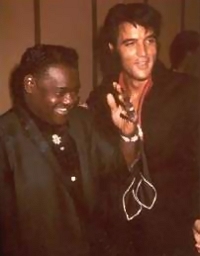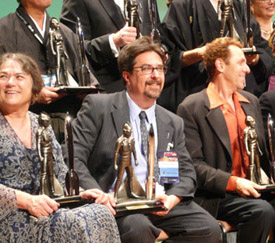The cream of this week’s musicalicious crop is oh, so creamy.
LittleHorse, Strangers in the Valley
I’ve been listening for the last couple of weeks to LittleHorse’s new album, their third, and it’s a keeper. (Also, judging from the somewhat lesser quality of the two songs they’ve remixed here from their previous CD, it’s probably the best.)
Led by two brothers, LittleHorse is a two-piano power-pop band that sounds a little like (take a deep breath) Queen plus a Latin band, and Billy Joel, backing up Joe Jackson, with Jellyfish on vocal harmonies. Or something. Whatever it is, it’s one of the year’s highlights – inventive but accessible, loaded with creamy harmonies, top-drawer musicality, and joyful fun. Highly recommended. Listen at their Myspace page, or at CD Baby where you can also buy it.
Eliza Lynn, The Weary Wake Up
Although I wasn’t terribly impressed with Eliza Lynn’s song on Putumayo’s recent Americana compilation, I like the label’s work so much that I almost automatically give a listen to anything from an artist they have included in the past. Lynn’s new CD turns out to be a solid, if not spectacular, set that embodies the term “Americana” in its broader sense, drawing on folk balladry, rock, blues, bluegrass, and jazz, but projecting a single characteristic voice.
Part of that consistency comes from Lynn’s literal voice, a cocky, cutting, but cloaked instrument that curls around cryptic lyrics like “You don’t know when it comes, cause it’s here before you’re ready. But if you walk it out the door, you’ll be begging it back on your knees.” In the brighter numbers, like “Hold My Breath,” “How Many Times,” and the Dixieland-style “Puddin’ Pie,” her smiling twang reminds me a little of Ellen McIlwaine, while her darker moments, like the trippy banjo-and-bass tune “Conrad” and the newgrassy “Bound,” express more of a snarly, Lucinda Williams sensibility.
“Intolerance Blues” is one of the more vivid political songs I’ve heard lately (and I’ve heard a lot). Lynn nails jingoistic country singers and right-wing hate radio with one swipe: “A country station is playing a song of vengeance, riding on patriotic hate… The country they sing of sounds like an angry drunkard – blinded and happy on his drug.”
And she picks a banjo as mean as her fights. Altogether, this is a nicely put together CD that grew on me with each listen. Sample the CD at her website or listen and buy at CD Baby.
Dave Sasscer, Quiet Mind
Here’s another artist who does a good job with a variety of styles.
First off: making relaxing soft rock that doesn’t get smarmy or sentimental is a neat trick, and David Sasscer pulls it off nicely here on several songs.
But as the set progresses one hears nods towards Santana, reggae, soul, funk, country, Eastern mysticism, and groovy, late 60s-style pop. Each song, though, has a simple, sweeping flow, even when rocking, which some of them do. The lyrics flow too, soulful and compact.
The only weakness, and it’s pretty minor, is that Sasscer’s singing, while sensitive, doesn’t have much power. Still it works all right in this easygoing, modest music. In fact just about everything about this CD is “all right,” in the best possible sense of the phrase. And playfulness does break up the meditative proceedings. The fun rocker “Dynamite” sounds a little like Jefferson Airplane, while “Jon Stewart is God” takes a good-natured poke at celebrity worship: “Jon Stewart is God / He made the earth and sky… from Genesis through Psalms / If you read between the lines / It’s Jon you’ll find.”
A lot of talented new indie artists mix and match from an assortment of musical styles. Not too many do it as smoothly and assuredly as Sasscer. Highly recommended. Hear and buy at CD Baby.
Riad Abdel-Gawad, El Tarab El Aseel: Autochthonic Enchantment
Living in New York City, I’m exposed to a fair amount of Arabic music. But I know very little about it. So I don’t have much context in which to place this recording by violinist Riad Abdel-Gawad. It sure sounds tasty and interesting, though.
Abdel-Gawad was born in Cairo, and although he was educated at Harvard and in western music conservatories, he explores his musical roots in the four pieces on this disc, mixing the taqasim (improvisational) tradition with tarab, the “performance practice of musical ecstasy.” Adbel-Gawad and his group use the oud (Arab lute), riqq (Arab tambourine), qanun (Arab zither), and nay (Arab flute), all traditional acoustic instruments, together with the violin, which has been co-opted into Arab music (replacing the indigenous two-stringed kamangah).
My untrained ears can’t tell for sure where composition ends and improvisation begins, or where the music adheres to historical forms and where it doesn’t, but I am enjoying it just the same. And on that latter point, Abdel-Gawad says something very interesting in his liner notes: before the advent of recording technology, it was the natural state of musical traditions to evolve. Afterwards, certain recorded performances became canonical, and so a distinction arose between historically “accurate” performances and “evolutionary” or “experimental” music. This is just as true of Western musical traditions as Eastern. And it is, in a sense, an artificial distinction.
I don’t have time to undertake a study of Arab musical traditions, and most likely you (dear Western reader) don’t either. What you can do is listen to these long, twisting, alternately trance-like and dramatic pieces, and I’ll wager you’ll find it a rewarding experience.





